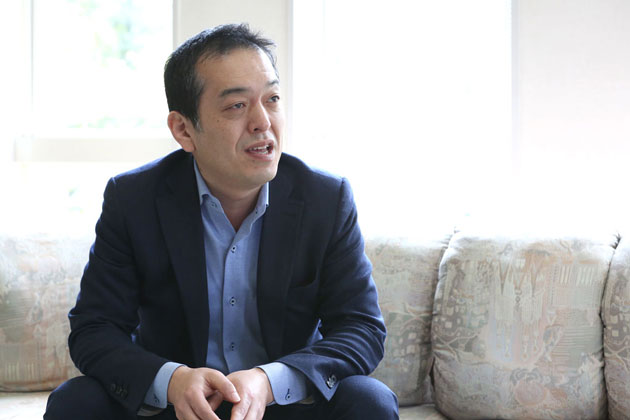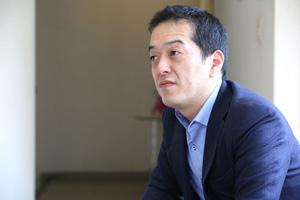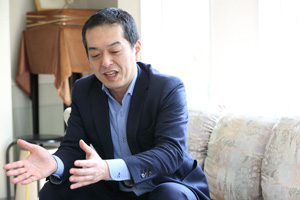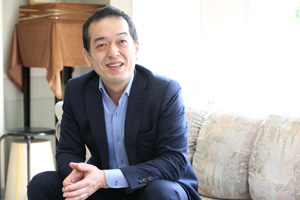
Interview: Representative Director Sugahara
Sghr (Sugahara), is a glass workshop in Kujukuri in Chiba prefecture where the artisans are involved through out the manufacturing process, from design to production. From a small workshop that is exists within the colorful scenery, countless number of glass products are produced every year, each carrying a message of "becoming a significant part of people's daily lives." As the representative director and an artisan, Mr. Sugahara told us his passion for maximizing the beauty of hand-made glasses.
JAPANTWO(JP2):Could you tell us how Sghr (Sugahara) was established?
Yusuke Sugahara (Mr. Sugahara):My grandfather founded this company 83 years ago(in 1932). Back then, the glass industry was really common in Tokyo's old town district and Sghr (Sugahara)started off as one of many factories. At that time, our factory was a subcontractor for wholesalers, who brought the mold, and we would make their glass products. (Original text:The wholesalers would bring the molds and we would reproduce them.) 52 years ago (in 1963), we moved to this Kujukuri in Chiba prefecture and after few years, we began designing and selling hand-made glassware.
JP2:The reason for choosing Kujukuri.
Mr. Sugahara:Since we had a small factory in Tokyo's old town district, my grandfather wanted "to work in a better environment," and began to look for relocation sites. Then, he happened to visit Kujukuri during his private time for viewing the cherry blossoms. He was really drawn by the warm climate of this Boso region so he decided to move here. There are many cherry blossom trees growing around this Sghr workshop, and you can see magnificent cherry blossoms during the season.

JP2:The charm of glass.
Mr. Sugahara:The first charm is that glasses are made from sand called "silica" which is a natural material. The second charm lies within the process of making glassware. By heating the silica sand to approximately 1400 degrees Celsius, it melts and liquify. Then you wrap this liquified glass around a tube and you blow into it to make shapes. For ceramic pots, you use your hands to shape them, but in the case of glassware you can make various shapes by changing the timing you blow into it. These shapes are unique expressions of the glass that cannot be created in molds or by hand; they can only be formed for their softness and it's a special charm that cannot be found in other materials. And during the time until this soft glass begins to solidify, you decide "when to blow," "how much to blow," and "how hard to blow," in order to determine the shape. This process is another charm of the glass.
JP2:Are there anything in particular about the sand you pay attention to?
Mr. Sugahara:Absolutely. The most important thing to consider when selecting the material is "whether it contains a lot of iron or not." Normally the surface of a glass sheet looks green, right? That's the color of iron. There are things that you can mix to diminish the green color, but the best option is to select the sand that doesn't contain much iron. Unfortunately, there aren't much quality sand that can be found domestically, so we import them from Australia.
JP2:What is interesting about making glassware?
Mr. Sugahara:This a little technical, but glass is very close to liquid form, composition-wise. In the case of ceramic pots, once they are baked and hardened, they can no longer be changed back to soft clay. However, in the case of glass cups, by gradually heating them up, they lose their shapes and melt, returning to their original liquid form. It's like how water freezes into ice and melts back into water, the liquid glass solidifies into the shape of a cup and it melts back into liquid when it is heated. Although there are many limitations due to this unique property that other materials lack, they have many possibilities too. This is what makes glass so fun and attractive.

JP2:What distinguishes Sugahara from other factories?
Mr. Sugahara:There is a wide range in the age of the 30 artisans working at Sugahara: the oldest being 65 years old, and the youngest being 20. Compared to other workshops, we have more youngsters and female artisans working here, which is quite unique. There are many female glass-makers working as "artists," but it's quite rare to find female artisans working in workshops anywhere around the world.
JP2:Why was company structured in this way?
Mr. Sugahara:The reason is that our production method is a little distinct. Normally, there would be people who plan and design the products. So the artisans' focus will be "to reproduce their products as accurately as possible." However, at Sghr (Sugahara) the artisans do everything: from the planning and designing to the production. When you get all of the artisans involved, like in our factory, we naturally get more youngsters who get interested in "the creative process."
JP2:What's the biggest advantage you have with this structure?
Mr. Sugahara:Young artisans usually have tonnes of ideas but often lack the skills to do many things. That's when the veteran artisans can teach them how to do them, or they can make the things that the young artisans come up with. In that way, the veterans and the younger artisans begin to communicate, while creating opportunities to pass on their skills. In addition, by working together with the younger artisans, the veterans can learn the "fresh" senses from the youths. Our veteran artisans are especially open to the ideas of the youngsters, so many of their own ideas become surprisingly flexible. So the advantage is that the veterans and the youngsters can complement each other, while absorbing the positive aspects and skills that each possess.
JP2:Are there any difference or any distinguishable feature between a piece that is made by men and a product that is made by women?
Mr. Sugahara:No. I believe we must reject the concept of "masculinity" and "femininity" within us. It may depend on the era, but there are many daring products made by women, and many intricate products made by men.

JP2:How do you come up with the designs?
Mr. Sugahara:More than coming up with good designs, we are focusing on creating a product that "maximizes the brilliance of the glass." We are thinking of how to maintain that brilliance in the product by changing the manufacturing method depending on the material used. If I exaggerate a little, we often get things like, "We came up with this wonderful product as a result of effectively using this material, but we have no idea what this can be used for."
Concerning the wine glass commission we received from Florilege, we had its utility in mind right at the start, so we began making them, while having numerous discussions with the chef about wine glasses.
JP2:You release many products each year, but have you ever had any problems coming up with new ideas for the products?
Mr. Sugahara:Never. There are times when we just make a product without any idea, and we begin to think of its utility after the completion. Other times, we use the product to generate ideas for the next product like, "Maybe I can change this part and use it for this purpose." Each year, we are producing over 200 pieces in various colors and shapes, but we can create products without having any particular idea in mind; we generate more ideas than the total number of products that are made. That is why even though we may suffer from the lack of skills, we never had problems with the lack of ideas.
JP2:What is something that Sghr (Sugahara) is focused on?
Mr. Sugahara:We are focused on "providing our Sghr (Sugahara) products to be used in people's daily lives." Whenever we make a product, we are not making them to be used as decorations for display, but we are thinking of them functioning in people's lives, and enriching them. We have decided that this is the common rule for all products. Also, our products are not priced too high nor too low, but they are very affordable as "crafts." This is because we want our products to be used in people's daily lives. Even if a particular product were to break in its everyday usage, we would want the price to be affordable for customers to replace it.

JP2:Do you operate overseas?
Mr. Sugahara:No, we don't. But we have a partnership with a Czech factory. They mainly produce art works such as pieces for the architect Borek Sipek. We have their artisans visit our workshop and have ours visit the Czech factory for technical exchange.
JP2:How do the Czech and the Japanese techniques differ?
Mr. Sugahara:The Czechs have big physiques so when it comes to making grand and audacious things, we can't beat them. However, when it comes to intricacy, care and technical precision, our artisans are much more skilled. When the Czech artisan visit us, our artisans assist them to make their products. But that's quite boring for them, so we get the Czechs to work in our product line to manufacture our products. Unfortunately, none of those products end up being sellable.
JP2:What are the things that make them unsellable?
Mr. Sugahara:For example, I get them to make a product with the mouth part that should be 1.2 mm thick. According to them, they feel that 1.2 mm and 1.5 mm are identical, so it's almost impossible for them to make a flawless piece that is exactly 1.2 mm thick.
Also if there remains a grain of sand that hasn't melted within the glass, our artisans will destroy it, no matter how close it is to completion. But the Czech artisans will get angry and question, "Why should we destroy it when it's almost done?" We do not sell products with these remains in them, but they do over there. Whether such product is acceptable or not, depends on the consumers' values. Japanese consumers are critical when it comes to "quality." That's why compared to other countries, Japanese artisans and engineers have developed the technology for intricate and detail-oriented works.
JP2:Are there anything that you benefited from the partnership?
Mr. Sugahara:Sometimes when I go to the partner factory in Czech, I see them making these intricate pieces that you'll never see in other European factories. When I see that, I am glad that we can share our techniques and learn from each other.
Also, I was pleased to have realized the importance of transmitting our unique Japanese values. I was making leather handbags at my previous job, but in Japan, if there's a scar in the leather, it's considered damaged and would be unacceptable. However, in other countries, a scar that was made when the animal was alive, is appreciated, considering it to be a proof of genuine leather. So for such things as transmitting the values of materials, I would like to do the same with glass.

JP2:Do you have any goals or challenges you would like to take on?
Mr. Sugahara:Our present goal is to make "Japanese wine glasses." Recently our glassware is beginning to be noticed by European chefs, but our wine glasses are completely disregarded; that's the issue we need to work on. The European wine glasses are made with the idea of how the wine smells and tastes when it is poured into them. To be honest, I don't think we are able to compete with them in that area. However, I think there are many other areas which glasses can show their characteristics. Recently, we have received an order of wine glasses from Florilege and we are beginning to really get involved in making wine glasses. Our goal is to improve the transparency of the glass as well as making the stem thinner, focusing on the comfort of holding the wine glasses.
Other than that, we would like to create more opportunities and circumstances for people to get to know our products. I want to spread that "there's something brilliant about Sghr (Sugahara) products."
JP2:Is there anything you are trying to communicate through your Sghr (Sugahara) products?
Mr. Sugahara:Are products are being used in fancy restaurants and they supplement the presentation of the food. Obviously that makes me happy, but I would like the general public to learn to enjoy using glassware in their daily lives. I'd like to receive comments like, "I didn't realize how different the food looks when I serve it in this plate," or "My wife and I always use these glasses to enjoy our evening drinks."
I would like everyone to try our products even to serve snacks you've brought home. You will definitely notice the difference.
Sugahara Glassworks Inc.
